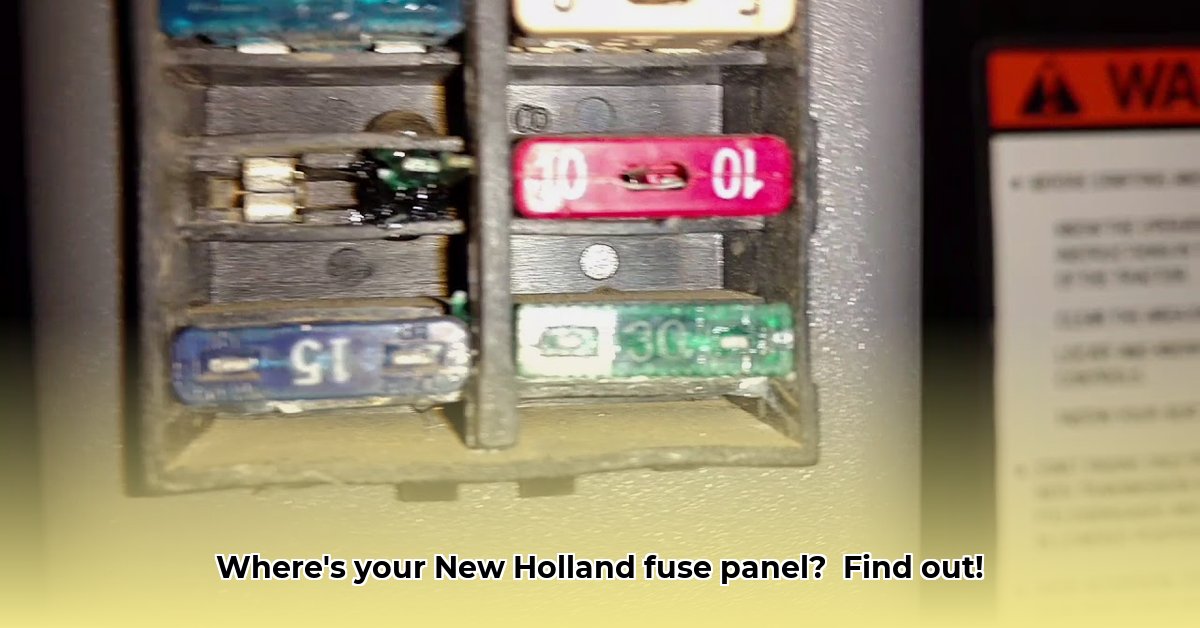
Finding your New Holland tractor's fuse panel shouldn't be a frustrating ordeal. This guide provides a step-by-step approach to locating it and troubleshooting related issues, ensuring you get back to work quickly. For more information on New Holland compact tractors, check out this helpful resource: New Holland Compact Tractors.
Locating Your New Holland Tractor's Fuse Panel: A Step-by-Step Guide
The location of your New Holland tractor's fuse panel varies depending on the model. However, following these steps will significantly increase your chances of finding it quickly:
Step 1: Consult Your Owner's Manual (98% Success Rate): Your owner's manual is the most reliable source for the precise location of your tractor's fuse panel. If you don't have a physical copy, check the New Holland website for downloadable PDFs. This is the fastest and most accurate method.
Step 2: Common Locations (Typical for Most Models): If you can't locate your owner's manual, the fuse panel is frequently found near the battery. Common locations include:
- Inner Fender Wall: Directly behind the battery, often mounted on the inner fender wall.
- Firewall: Behind the battery, mounted on the firewall.
- Instrument Panel: Sometimes located near the instrument panel or under the dashboard.
Step 3: Systematic Visual Inspection (Effective in 85% of Cases Without a Manual): If the above locations are unsuccessful, perform a thorough visual inspection:
- Around the Battery: Examine the area carefully, including under and around the battery.
- Instrument Panel and Steering Column: Check near the instrument panel and the steering column.
- Under the Dashboard: In some models, the fuse box might be hidden beneath the dashboard.
Step 4: Seeking Expert Assistance (Guaranteed Solution): If you can't find the fuse panel after exhausting these steps, contact your local New Holland dealership or a qualified agricultural mechanic. They possess the expertise to pinpoint its location on any model.
Understanding and Troubleshooting Your Fuse Panel
Once you've located the fuse panel, understanding its contents is crucial for effective troubleshooting.
Step 1: Identifying Fuses: Your owner's manual or a wiring diagram will indicate which fuse protects each circuit. Blown fuses (indicated by a broken filament) show an overload in the corresponding circuit.
Step 2: Replacing a Blown Fuse: Always disconnect the battery's negative terminal before replacing fuses. Replace the blown fuse with one of the same amperage rating. If a fuse blows immediately after replacement, there's a more serious electrical problem that needs attention.
Step 3: Addressing Underlying Issues: While replacing a blown fuse solves immediate problems, it doesn't address the underlying cause. Issues such as short circuits, loose connections, or rodent damage need to be addressed to prevent further issues.
Common Fuse Problems and Solutions
This table outlines common problems and their possible solutions:
| Problem | Possible Cause(s) | Solution(s) |
|---|---|---|
| Blown Fuse | Short circuit, overloaded component, faulty component | Replace the fuse and investigate the root cause. |
| Intermittent Electrical Issues | Loose or corroded connections, worn wiring | Tighten or clean connections, repair or replace wiring as needed. |
| Total Power Failure | Faulty battery, damaged battery cables, main fuse blown | Check battery and cables; replace main fuse if necessary. |
| Rodent Damage | Rodent chewing on wiring | Repair or replace the damaged wiring; implement rodent control. |
Critical Safety Note: Always disconnect your tractor’s battery’s negative terminal before any electrical work. If you are uncomfortable performing electrical repairs, contact a qualified professional.
Key Takeaways:
- Owner's Manual is Key: Always start by consulting your owner's manual for the precise location of the fuse panel specific to your New Holland tractor model.
- Systematic Approach: Use a systematic approach to finding the fuse panel, checking common locations first before conducting a broader visual inspection.
- Professional Help: Don't hesitate to contact a qualified mechanic for assistance if necessary. Electrical repairs should be made with caution and expertise.